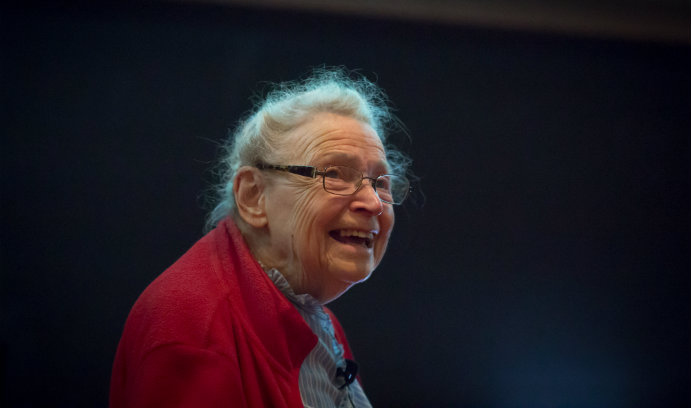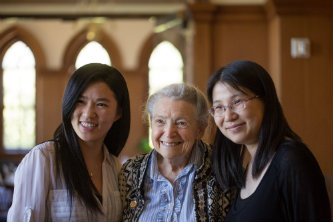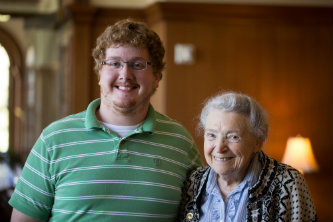A lifetime of learning

Dresselhaus, an Institute Professor in the departments of physics and electrical engineering at the Massachusetts Institute of Technology, told the story of her career and those who influenced it.
For a semester during her time as a doctoral student at the University of Chicago in the 1950s, a young Mildred Dresselhaus shared a daily walk to the lab with Enrico Fermi.
“He was an early riser, I was an early riser,” Dr. Dresselhaus said of her walks with the Nobel Prize-winning Italian physicist who created the world’s first nuclear reactor. “He would cross the street and walk with me every morning. So for a whole semester we would walk together, and he would tell me what he was thinking about in the world of science and in life and all that.”
Dr. Dresselhaus, a renowned and highly influential physicist in her own right, shared the story of her career and the individuals who helped shape it during a public lecture on Sept. 14 in Lewis Lab.
An Institute Professor in the departments of physics and electrical engineering at the Massachusetts Institute of Technology and a longtime advocate of women in science, Dr. Dresselhaus has served as director of the Office of Science at the U.S. Department of Energy, president of the American Physical Society, treasurer of the U.S. National Academy of Sciences and president of the American Association for the Advancement of Science. Among many accolades, she has received the U.S. National Medal of Science, the Nicholson Medal for Humanitarian Service, the Compton Award, the Fermi Award, the Kavli Prize, the Presidential Medal of Freedom and 36 honorary doctoral degrees, including one from Lehigh in 2013. She is known as the “Queen of Carbon” for her work in carbon nanomaterials and graphite, just one focus of a career that has spanned nearly 60 years.
And yet, when asked by an audience member during the question-and-answer session following her talk if she ever felt uncertainty or self-doubt, she replied, “Let me assure you, every day when I wake up I still feel like that.”
Her talk included several “take home messages,” advice based on a career influenced by an extensive list of distinguished mentors.
The Soviet Union’s launch of Sputnik in 1957, Dr. Dresselhaus said, made it possible for her to begin her independent career after completing her Ph.D. and postdoctoral work in 1960.
“Sputnik told the Americans that we were behind the Russians. Oh, that didn’t go over with the American population at all. So there was a big rush to improve education in the U.S. and catch up with the Russians. And I was a beneficiary of that, because in 1960, when I started my independent career, there were lots of jobs available for people that knew something. And I had had a good education, and even though I was a woman, I could get a job.
“Education is important,” she said. “Please take that home as a starting principle.”
Dr. Dresselhaus recalled first wanting to be a school teacher. Then, while studying as an undergraduate at Hunter College in New York, she met Rosalyn Yalow. Yalow taught physics at the then all-women’s college, and she encouraged Dr. Dresselhaus to pursue physics. Yalow would later receive the Nobel Prize in Medicine in 1977 for developing the radioimmunoassay (RIA) technique, which “had a big impact on the influence of physics on the medical world.
“She was a big influence, and she kept on pushing me [to pursue physics],” said Dr. Dresselhaus of Yalow.
Dr. Dresselhaus learned from Fermi, she said, “how to think about physics and how to think about life. ... Anything that I feel good about teaching, I think I can probably trace to what I learned from Enrico Fermi. ... I would say he was my greatest teacher ever.”
From Ali Javan, the Iranian-American physicist and inventor of the continuous wave (CW) laser, Dr. Dresselhaus learned the importance of collegial relationships. Javan, a colleague at MIT, designed and built a laser that made it possible for Dr. Dresselhaus and a student to conduct the first laser experiment done in a magnetic field.
“If you have an idea, and you have some good friends, sometimes you can get some equipment built,” said Dr. Dresselhaus with a smile.
Ben Lax, who produced groundbreaking research in semiconductors and served as associate director of MIT’s Lincoln Lab, gave Dr. Dresselhaus the freedom to explore high magnetic field research in addition to the work she was doing with him on silicon. “Figure out a way to do what you want plus what you’re supposed to do,” she advised the audience. “You’ll find that’s a good combination.”
Dr. Dresselhaus expressed a keen interest in the teaching methods of her mentors, which also included colleagues from around the world and her own students. She also emphasized learning from everyone.
“Talk to your budd[ies]. You’ll learn a lot from them. And for faculty, talk to your students. You’ll learn a lot, and you’ll keep learning from them,” she said.
The nearly 86-year-old physicist continues her work in earnest and shows no signs of slowing down. Science keeps her young, she said. She joked that she’s now enjoying the longevity associated with being a woman in her field, referencing the longer life expectancy of women in the United States.
“For me, when I reached 65, that was only the beginning. That’s more than 20 years ago, and I’ve done my best work since then. I’ve had more time to work on it,” she said.
Photos by Christa Neu
Posted on:






